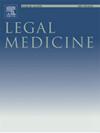CT-assisted age estimation from the medial clavicular epiphysis in the Greek population according to Schmeling and Kellinghaus classification
IF 1.3
4区 医学
Q3 MEDICINE, LEGAL
引用次数: 0
Abstract
Examining the clavicle by macroscopic or radiologic techniques is a well-established method in forensic age estimation in living and dead individuals. The present study examined 196 CT (computed tomography scan) images of native patients from the archive of the medical imaging laboratory of the University Hospital in Heraklion, Crete, in Greece. The ossification of the medial clavicular epiphysis was classified according to Schmeling et al. and the extended amplified staging system of Kellinghaus et al. Next, a stage transition analysis was carried out according to the Bayesian model. Probability density functions were calculated using informative priors for age distribution in the total population, deceased and violently deceased individuals. Our study showed that when the medial clavicular epiphysis’ ossification is sorted in stages 4 and 5 in Greek males and females, the cumulative probability of adulthood (≥18 years) is nearly 1. As far as Greek males are concerned, in stage 3c, the cumulative probability of adulthood (≥18 years) is 0.86, and in Greek females in stage 3c, the cumulative probability of adulthood (≥18 years) is 0.97. This is the first study of age estimation based on the ossification of the sternal clavicular end using CT in a Greek population.
根据施梅林(Schmeling)和凯林豪斯(Kellinghaus)的分类法,从希腊人的锁骨内侧骨骺进行 CT 辅助年龄估计。
通过宏观或放射技术检查锁骨是一种成熟的方法,在法医年龄估计活着和死亡的个人。本研究检查了来自希腊克里特岛伊拉克利翁大学医院医学影像实验室档案的196张本地病人的CT(计算机断层扫描)图像。根据Schmeling等和Kellinghaus等的扩展放大分期系统对锁骨内侧骨化进行分类。其次,根据贝叶斯模型进行了阶段过渡分析。使用信息先验计算总体、死亡和暴力死亡个体的年龄分布的概率密度函数。我们的研究表明,当希腊男性和女性锁骨内侧骨化分4期和5期时,成年(≥18岁)的累积概率接近1。希腊男性在3c阶段,成年(≥18岁)的累积概率为0.86,希腊女性在3c阶段,成年(≥18岁)的累积概率为0.97。这是首次在希腊人群中使用CT根据胸骨锁骨末端骨化进行年龄估计的研究。
本文章由计算机程序翻译,如有差异,请以英文原文为准。
求助全文
约1分钟内获得全文
求助全文
来源期刊

Legal Medicine
Nursing-Issues, Ethics and Legal Aspects
CiteScore
2.80
自引率
6.70%
发文量
119
审稿时长
7.9 weeks
期刊介绍:
Legal Medicine provides an international forum for the publication of original articles, reviews and correspondence on subjects that cover practical and theoretical areas of interest relating to the wide range of legal medicine.
Subjects covered include forensic pathology, toxicology, odontology, anthropology, criminalistics, immunochemistry, hemogenetics and forensic aspects of biological science with emphasis on DNA analysis and molecular biology. Submissions dealing with medicolegal problems such as malpractice, insurance, child abuse or ethics in medical practice are also acceptable.
 求助内容:
求助内容: 应助结果提醒方式:
应助结果提醒方式:


